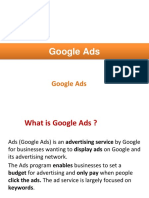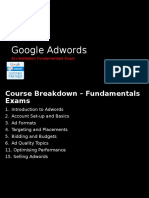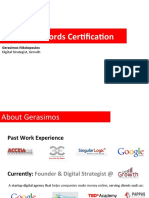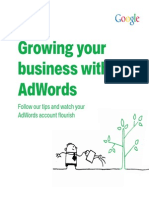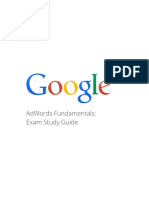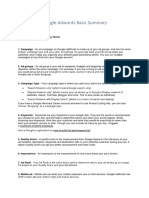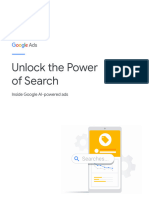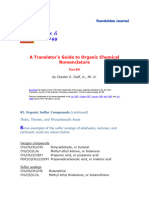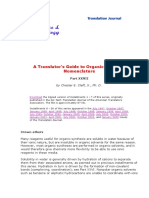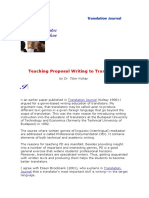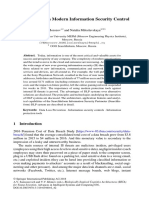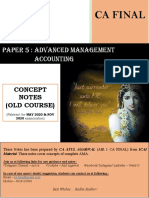— Google confidential —
AdWords and Google Translator Toolkit Best Practices Guide
Date Update Section
April 20, 2017 -IF functions -Ad Text (page 14)
March 16, 2017 -Guidelines for how to localize URL paths for -Display URLs / URL
non-Latin alphabets paths (page 16)
-Guidelines for capitalization & accents in URL
paths
March 2, 2017 - Added instructions on what defines a - Misspelled keywords
keyword when it comes to deleting misspelled (page 10)
KWs
February 14, 2017 - Small tweak to instructions on compounds in - Keywords (page
keywords 9/10)
February 7, 2017 - Added instructions on compounds in - Keywords (page
keywords 9/10)
January 18, 2017 - Added instructions for - Keywords (page 9)
transliterating/translation brand names/terms - Miscellaneous (page
- Added instructions on the translation of place 17)
names
January 5, 2017 Added an explanatory note on what Glossary Miscellaneous section
means (page 17)
December 21, 2016 - Implemented new lay-out of entire document - N/A
- Added instructions on translating URL paths - Display URLs
and not using spaces
This document contains links to definitions, details, and policies on the official AdWords Help Center. We
have structured it this way to ensure you always have the most up-to-date information on all of these
topics. Please click through to read more about each of these concepts. Thank you!
Content of this document
Short intro to AdWords campaigns 3
How campaigns are set up 3
How campaigns work 3
How ad groups work 4
Main AdWords campaign elements 5
Keywords 5
Broad match 5
1
— Google confidential —
Broad match modifier 5
Phrase match 5
Exact match 5
Negative keywords 5
Term used both as a positive and negative keyword 6
Text ads 6
Standard vs Expanded 6
Display URLs 6
Dynamic Keyword Insertion 6
What it looks like 7
Why advertisers use it 7
Ad extensions 7
Universal app ad ideas 7
Localization instructions 9
Keywords 9
Broad Match Modifier (BMM) 9
Misspelled keywords 10
Negative keywords 10
Optimizing high-traffic keywords 10
Keyword errors 11
Ad text 12
Standard ads character limits 13
Expanded text ads character limits 13
Notable AdWords policies 13
Intercapitalization 13
Display URLs 15
Dynamic keyword insertion 16
Editorial policy for text ads 16
Miscellaneous 16
Glossary 17
Short intro to Google Translator Toolkit (GTT) 18
2
— Google confidential —
Short intro to AdWords campaigns
How campaigns are set up
The key concepts of AdWords campaigns are:
● Keywords
● Text ads
● Display URLs
● Ad extensions
● Universal app ad ideas
Other important definitions to be familiar with are:
● Ad groups: An ad group contains one or more ads which target a shared set of
keywords.
● Campaigns: A set of ad groups (ads, keywords, and bids) that share a budget, location
targeting, and other settings.
How campaigns work
AdWords is organized into three layers: account, campaigns and ad groups.
1. The account is associated with a unique email address, password and billing
information.
2. Campaigns have their own budget and settings that determine where your ads appear.
3. Ad groups contain a set of similar ads and keywords.
Account
Unique email and password
Billing information
Campaigns Campaigns
Budget Budget
Settings Settings
Ad group Ad group Ad group Ad group
Ads Ads Ads Ads
Keywords Keywords Keywords Keywords
More information on how a campaign works, can be found here.
3
— Google confidential —
How ad groups work
An ad group contains one or more ads which target a shared set of keywords. You set a bid, or
price, to be used when an ad group's keywords trigger an ad to appear. This is called a cost-
per-click (CPC) bid. You can also set prices for individual keywords within the ad group. Use ad
groups to organize your ads by a common theme, such as the types of products or services you
want to advertise.
Why do advertisers theme their ad groups?
● All of the keywords in a given ad group can trigger the same ad(s). Making sure all
keywords in an ad group are tightly themed helps ensure your ads are highly relevant to
all of your keywords.
● Be sure that any keywords you add are relevant to the landing page specified by the
final URL (not the display URL) of the associated ads. It is important that the keywords
are relevant to that specific page, and not to just any page on the client’s website.
→ More information on how ad groups work can be found here. ←
Main AdWords campaign elements
Keywords
Keywords are words or phrases describing the product or service that the advertiser chooses to
help determine when and where their ad can appear. There are different keyword match types
that help control which searches trigger an ad.
4
— Google confidential —
Broad match
Broad match is the default match type that all your keywords are assigned to. Ads may show on
searches that include misspellings, synonyms, related searches, and other relevant variations.
Example keyword: women’s hats
Example search: buy ladies hats
Broad match modifier
Ads may show on searches that contain the modified term (or close variations, but not
synonyms), in any order.
Symbol: +keyword
Example keyword: +women’s +hats
Example search: hats for women
Phrase match
Ads may show on searches that are a phrase, and close variations of that phrase.
Symbol: “keyword”
Example keyword: “women’s hats”
Example search: buy women’s hats
Exact match
Ads may show on searches that are an exact term and close variations of that exact term.
Symbol: [keyword]
Example keyword: [women’s hats]
Example search: women’s hats
→ More information on keywords can be found here, more information on match types
can be found here. ←
Negative keywords
Advertisers use negative keywords to prevent their ads showing to people searching for items
they don’t offer. Say your company sells many different types of boots (rain boots, work boots)
but not hiking boots. You’d likely want to run on the term “boots,” but if you do so, your ads will
likely show in response to searches for “hiking boots.” To combat this, you can implement
“hiking” as a negative keyword, which will prevent your ads from showing in response to “hiking
boots” queries.
→ More information on negative keywords can be found here. ←
Term used both as a positive and negative keyword
It’s common practice for advertisers to run the same keywords in different match types in
different ad groups or campaigns. For example, they may run exact keywords [keyword] and
5
— Google confidential —
[keyword2] in one ad group, phrase keywords “keyword” and “keyword2” in another, and
broad keyword and keyword2 in a third. Then, in the broad ad group, they would also run
[keyword] and [keyword2] as well as “keyword” and “keyword2” as negative keywords.
This, combined with strategic bidding, allows them to funnel queries to trigger the most specific
possible keyword in their account.
Text ads
A text ad is a form of marketing communication that advertisers can use to promote their
product or service on the Google Network. Text ads on the Search Network show above and
below Google search results. A text ad on Google search is the simplest online ad that
AdWords offers. It has three parts:
● headline text (2 lines)
● a display URL
● description text
→ More information on text ads can be found here. ←
Standard vs Expanded
As of January 31, 2017, Google offers only Expanded Text Ads. These differ from standard text
ads (the old version) in a few important ways. They have:
● Two headline fields (up to 30 characters each)
● A single, expanded description field (up to 80 characters)
● A display URL that uses your final URL’s domain
● Two optional Path fields, used in the ad’s display URL (up to 15 characters each)
Display URLs
The webpage address that appears with the ad, typically shown in green text. Display URLs tell
the searcher where they will be directed after clicking on the ad.
→ More information on Display URLs can be found here. ←
Dynamic Keyword Insertion
Keyword insertion lets an advertiser automatically update their ads with the keywords in their ad
group that caused their ads to show. This can help make the ads more relevant to users
searching for what the advertiser offers.
→ More information on Dynamic Keyword Insertion can be found here. ←
What it looks like
You’ll see instances of {KeyWord:<some text>} in the ad text.
Why advertisers use it
Say your company sells many different types of chocolate. If you add a keyword insertion code
to your ad, AdWords will try to replace the code with one of the keywords in your ad group
based on the user’s search query. This can help make your ad even more relevant to users. If
6
— Google confidential —
replacing with the appropriate keyword would make the description line too long, then the
default text supplied by the advertiser will be used.
Ad extensions
Sitelink ad extensions are short snippets of text with links to specific pages on an advertisers'
website, found below the text ad. Each sitelink is limited to 25 characters (12 characters in
double-width languages), and optionally has 2 description lines in addition to the link text.
Those description lines have the same length requirements as description lines in text ads.
Callout extensions follow similar guidelines as sitelinks; the main difference between the two is
that callouts do not have associated landing pages and are always one line of text.
→ More information on sitelinks can be found here, and on callout extensions here. ←
Universal app ad ideas
● Ads for universal app campaigns work differently than regular text ads. Users may
submit 4 lines of ad text, all of which are independent from one another.
● These ad texts are used in various types of ads. Google ads system automatically fits
these ad texts into the ads to achieve the best performance. There is no absolute
mapping that which ad text will be which position in the ads. Please see the examples
below about how the ads look like.
● The UI for translating ad ideas in universal app campaign is slightly different than the
one for translating keywords, text ads and ad extensions. As context, the UI will provide
app icon, app description, screenshots, and an optional Youtube video ad.
●
Google Play store
Google search ad Google partner ad
Each line of universal app ad text shares the same character limit (25 characters) and most
policies and practices with headline of text ad.
7
— Google confidential —
Please refer the section about text ads for details on how to handle intercapitalization and
editorial policy.
→ More information on universal app campaigns can be found here. ←
Localization instructions
Keywords
● Localize keywords rather than translating literally or word-by-word. Keep in mind how
users would search for these terms on Google.
● Word order in keywords is very important, especially when using exact or phrase
match. When localizing keywords containing more than one word, please enter them in
the exact order that a user in the target language would be most likely to use (which
may be different than the order in the source language). For instance, if the source
campaign in an English-->French request contains the keyword “red dress,” we’d ask
that you translate it as “robe rouge” rather than maintaining strict word order.
○ Exception to the above: if the source campaign contains multiple variants of the
same key terms in a different order, this implies the advertiser is trying hard to
ensure coverage against all possible searches. For instance, if an English--
>French request contains both the source keywords “red dress” and “dress red,”
we ask you to include both “robe rouge” and “rouge robe” as translations. Again,
this only applies to exact and phrase match keywords.
○ To be very specific: in the case where both versions exist in the source, please
translate the "properly-ordered" keyword (in this example, "red dress") to the
"properly-ordered" translation (in this case, "robe rouge") and vice versa.
However, if either of the two source English versions are equally likely to be
searched, just translate the first instance in the "most correct" way and the
second instance in the opposite way.
8
— Google confidential —
○ If in the above scenario, the source keywords were both on broad match, don’t
worry about including versions in both orders. Just include the most correct
translation for one of the keywords, and delete the translation for the other, as
two identical keywords in the same ad group and match type will cause a
submission error.
● Many advertisers run on keywords across multiple match types. These are not errors;
please keep all versions.
● If there are two or more possible translations for a given keyword, choose the one that
most people would use in the target language and use it consistently, and add the
other(s) as a new keyword in that ad group.
● If a campaign has keywords in multiple languages, don’t translate keywords not in main
language (indicated by user). Please delete the proposed keyword corresponding to the
source keyword that was in the different language by manually deleting the translation.
○ Exception: if the keyword in the source campaign is in the target language (i.e. if
there’s a Japanese keyword in an English campaign that is being translated into
Japanese), then please leave that keyword.
● Never translate brand terms (terms consisting of the name of the advertiser or their
product lines), unless you are translating from a Latin-alphabet language to a non-Latin-
alphabet language. If a keyword contains a brand name as well as non-branded terms,
i.e. “Goodyear tires,” please translate the non-branded terms but leave the brand term
as it is in the source keyword. If you are translating keywords from a Latin-alphabet
language to a non-Latin-alphabet language, please include both the fully-untranslated
version and a transliterated version, if appropriate for your language. If you’re translating
of Ads, please use the name the company uses themselves. For example, Facebook in
Arabic is transliterated on their own website, therefore we should use the transliterated
name in the Ad. If there is no transliterated or translated name, please use the English
name of the brand.
● Do not change negative keywords (listed under “NEGATIVE KEYWORDS” in the
interface ) to positive keywords, and do not add keywords on the negative keyword list to
the positive keyword list. Negative keywords are used to block specific kinds of traffic
and should stay as they are.
● Keywords aren't case-sensitive — they're matched without regard to uppercase or
lowercase letters. For example, you don't need to enter running shoes and Running
Shoes as keywords — just running shoes will cover both. For AdWords translations,
please do not make changes to keyword case — keep them as they were when you
received the translation.
● If your language uses compounds and source terms could be either searched for as a
compound or as separate words, you can add both options in the target but you’re not
obliged to Using either one of the options is fine, ideally the one is most searched for.
Example: if videochat needs to be localized, you can use +videochat and +video +chat
in the translation. If your language uses hyphens to compound, you can use both +video
+chat and +video-chat as keywords. If you know or do research and find out that +video
+chat is used most often, it’s fine to just use this.
9
— Google confidential —
● Prepositions in keywords: on broad match, it does not matter if you use prepositions
or not. However, for phrase and exact match keywords, you must include prepositions in
keyword translations.
Broad Match Modifier (BMM)
● When translating keywords using a broad match modifier (BMM) (signified with a “+” sign
before one or more terms in a keyword), the “+” should directly precede the modified
term, with no space in between it and the term.
● If a keyword does not have a BMM, do not add any BMMs to the translated term.
● If a keyword has BMMs on all words in the keyword, include a BMM on each word in the
translated keyword EXCEPT for prepositional or similar phrases like “the” or “di.”
● If a keyword has BMM on some but not all words in a keyword, include a BMM only on
the word(s) that are translations of the words with BMMs from the original keyword.
Misspelled keywords
● If you see a misspelled version of a keyword in an ad group, please delete the translated
keyword corresponding to the misspelled source keyword. This also applies to ad groups
that are made up entirely of misspelled keywords. Note that keywords can also be entire
strings and not just one term within it.
● If your language has multiple correct spellings of the same word, you can insert these
alternate spellings as translations for the source misspellings.
Negative keywords
● Generally, approach translating negative keywords as you would positive keywords
● If there is a misspelled source negative keyword, delete the corresponding target
keyword.
● Do not add any negative keywords in the campaign as positive keywords.
Optimizing high-traffic keywords
To help translators come up with highest-quality translations, we flag keywords that are getting
relatively more searches in the new language than what they were getting in the original
language. Because these keywords may result in a large volume of traffic, translators should be
sure to review especially carefully to make sure that they're relevant to the campaign and
translated correctly.
Even when you edit flagged keywords, keep in mind that the flag will remain (i.e. stay red).
However, you can set up color coding in Google Translator Toolkit for all segments that have
been edited instead.
10
— Google confidential —
Translators can also create new keywords that are relevant to the campaign by clicking the plus
button. Please do this in cases where there is more than one possible and appropriate
translation of a particular keyword and both represent common ways for speakers of that
language to search.
Keyword errors
11
— Google confidential —
● Duplicate keywords Even though a keyword duplicate (with the same match type) is an
error in the campaign, it is NOT an error in Translator Toolkit. If translators encounter the
duplicated versions of the same keyword with the same match type,
○ A best effort should be made to use synonyms where possible
○ However, if this is not possible, they can enter the same translation for both and
our system will take care of it automatically after translation completion.
● Policy violation errors All AdWords campaigns need to comply with Google AdWords
policies, which are fairly strict in order to protect our users. Keywords that violate
AdWord policies, will be flagged with this symbol: .
The detailed error message with reason and solution will be displayed in the edit box.
Translators should fix all violation errors upon completion.
Ad text
● It is important to retain the full meaning of the original ad in the translated version, even
if the best translation causes the ad to be too long. If translating the ad as-is exceeds
AdWords character limits, please revise the ad as needed to be shorter while preserving
the original meaning and tone.
● Always capitalize location names and brand terms in ad text.
● Be sure that translated ad text fits within the character limits outlined here under “Length
limits”.
● Do not add a dash in Expanded text ads headlines to break up the headline, as the
system will add a dash automatically between headline 1 and headline 2. Using a dash
in the middle of the text of the headline itself is fine if it makes sense in your locale
● Do not add exclamation marks in headline 1 or headline 2 of Expanded text ads.
12
— Google confidential —
Standard ads character limits (in general, you should stop seeing these after Jan. 31, 2017)
*Double-width languages include Chinese, Japanese, and Korean.
Expanded text ads character limits
● In Expanded text ads, the length limits are the same across all languages. Each
character in double-width languages like Korean, Japanese, or Chinese counts as two
towards the limit instead of one.
● We recognize that it can sometimes be difficult to stay within character limits while
preserving meaning. It’s most important to preserve meaning. If doing so while staying
within limits is not possible, and you are trying to make a decision between removing
registered/TM symbol and punctuation symbols, please file query in QM.
● Expanded Text Ads and the Bamboo UI: if the source campaign has an expanded text
ad, then the Bamboo UI will be customized to support expanded text ads and their new
specifications. If the source campaign has a regular/standard text ad, then the UI will be
customized to support the standard text ad specifications. We will not ask translators or
reviewers to change an ad from standard to expanded; we will only ask that if the source
is standard, localize to standard, and if the source is expanded, localize to expanded.
Both ad types will come through for the near term, but eventually (expected early Q4)
expanded text ads will be our only text ad format.
● Abbreviations: it’s far preferable to use full words rather than abbreviations, but
abbreviations are allowable if needed to fit within character limits, assuming the
abbreviation will be easily understood by users in that language.
Notable AdWords policies
Please make sure all ads comply with the AdWords policies. Some notable policies are as
follows:
13
— Google confidential —
● No exclamation point/mark (‘!’), in the headline.
● At most one exclamation point/mark per text ad.
IF functions
● IF functions allow you to insert a specific message in your text ad when a condition is
met, and a default text when it does not. IF functions are parameters that go within
braces {like this}. The parameter gets replaced by the text you specify when your ad
is triggered by a person’s search. You can include IF functions anywhere in your text
ad except for the final URL field.
● In terms of how this affects character limits: The longer text (from insert & default
text) from each function is used to check character lengths
● Character length checks :
○ The longer text (from insert & default text) from each function is used to
check character lengths. Note that Editor can't do this - it doesn't understand
the meaning of ad customizers, it only understands the syntax just well
enough to locate default value (if any) and count it in display width. So Editor
can handle default text, but not the insert text.
○ If multiple if functions are present in a same line, we use the longer text from
each function for validation.
○ If keyword insertion is also present in the same line, we use the default text
from the keyword insertion for validation.
○ If Ad Customizers is also present in the same line :
■ If the customizer has a default text, we use the default text
■ If the customizer does not have default text, we count 0 characters for
the customizer.
Intercapitalization
In general, there are 2 types of capitalisation for ad texts:
Normal capitalization: Intercapitalization
(each word except prepositions or articles)
Alamo® Car Rental Discount Car Rentals
Lines are for amateurs! Save time Get Our Best Price Guarantee on
w/ self-service car rental kiosks. Your Next Car Rental at Expedia.
Always follow the case style in the source ad unless the target language has strict rules for
capitalization (i.e. German) or the capitalization looks incorrect in the target language. Please
consult the table below to see which capitalisation type applies to your target language.
Target Language Should I intercapitalize ad text?
German No; follow target language capitalization rules
14
— Google confidential —
English Yes (except for prepositions, articles, conjunctions. Exe: and, or,
the, an, etc.)
French No; follow target language capitalization rules
French (CA) No; follow target language capitalization rules
Italian Yes (except for prepositions, articles, conjunctions Exe: and, or,
the, an, etc.)
Dutch No; follow target language capitalization rules
Spanish Yes (including US Hispanics Spanish-speaking LATAM, and except
for prepositions, articles, conjunctions Exe: and, or, the, an, etc.)
Swedish No; follow target language capitalization rules
Norwegian To be defined (follow target language capitalization rules for the
moment)
Finnish To be defined (follow target language capitalization rules for the
moment)
Danish To be defined (follow target language capitalization rules for the
moment)
Russian No; follow target language capitalization rules
Polish No; follow target language capitalization rules
Portuguese Intercapitalisation in headline only*
Romanian Intercapitalization in headline only*
Arabic To be defined (follow target language capitalization rules for the
moment)
Japanese No; follow target language capitalization rules
Vietnamese To be defined (follow target language capitalization rules for the
moment)
Hebrew N/A
Chinese Simplified To be defined (follow target language capitalization rules for the
moment)
15
— Google confidential —
Chinese Traditional Intercapitalization in headline only*
Turkish Y (except for prepositions, articles Exe: and, or, the, an, etc.)
Czech To be defined (follow target language capitalization rules for the
moment)
Hungarian To be defined (follow target language capitalization rules for the
moment)
Afrikaans To be defined (follow target language capitalization rules for the
moment)
Indonesian To be defined (follow target language capitalization rules for the
moment)
*“Intercapitalization in headline only” means that you have to intercapitalize the headline, but
should follow your target language grammar rules for the rest of the ad text. If your language is
not mentioned here, please follow target language capitalization rules.
Display URLs / URL Paths
● Never change the domain or country ending of any URL. If a requester needs to change
the country ending, they need to specify this when they make their request, so any
country endings you see in GTT reflect the updated country ending the requester asked
for.
○ We therefore do translate any word or words of a subdomain (i.e. what comes
before the main domain) or anything that succeeds the main domain (i.e.
anything after the /). When localizing books.amazon.it or amazon.it/books, the
translations will look like this: amazon.ca/libri and libri.amazon.it.
● URLs cannot contain spaces, e.g. bose.co.uk/SansFil is correct but bose.co.uk/Sans fil
isn’t.
● URLs should not use underscores to join 2 words (i.e. black_shoes) UNLESS it is used
in the source. If you need a way to join 2 words in the target, please either use a dash (-)
or combine the words into one word (i.e. BlackShoes) if this makes sense in your locale.
● For languages with a non-latin alphabet, please follow the below guidance:
○ AR & RU: Translate URL paths normally
○ zh-CN: Translate URL path normally
○ zh-TW, zh-HK, KO, IW, HI: Keep the URL path in English.
○ JA & TH: Delete the URL paths
● Capitalization: Follow the source when determining whether or not to capitalize the URL
paths
● Special characters, specifically accents, should be included in URL paths
16
— Google confidential —
Dynamic keyword insertion
● If an ad uses DKI, be sure not to translate or make changes to the word “Keyword”
(may also appear as “keyword,” “KeyWord,” “KEYWord,” or “keyWORD”) when it
appears inside of curly brackets ({ }). The word “Keyword” is the way AdWords
recognizes the use of DKI and if it changes, keyword insertion won’t work as intended.
However, please do translate the default text (i.e. the text that follows the : [colon])
● The capitalization in the “Keyword” element of the ad impacts the capitalization of the ad
text. You may change the capitalization on the “Keyword” element as in order to ensure
the capitalization in the new language is appropriate to that language.
● Any keyword associated with the ad group may be inserted into the ad -- which one
depends on which is determined to be most relevant to the search term used (i.e. the
one entered into Google.com). Please review and keep this keyword list in mind when
translating ad text containing instances of DKI.
Editorial policy for text ads
If the translation for any line of AdWords text is over the limit, Translator Toolkit will flag it with
an error (see below for an example). In cases like this, please rephrase as necessary so that
the text fits.
→ More information on editorial policy for text ads in this article. ←
Miscellaneous
● For requests into English: unless one or more of the following is true, please translate
into EN-US.
○ Geo-targeting for the campaign is set to “United Kingdom”
○ Display URL of the campaign has a .co.uk ending
○ Requester notes specifically request EN-GB
● Currency: To determine format of the currency and amount, reviewers should follow
Glossary*, but if no Glossary entry, then follow source text. Reviewer can make
changes to the format (i.e. adjusting . to ,) in case this is in alignment with the market
standard regardless of whether there is a Glossary entry or if the source text is followed.
17
— Google confidential —
*The Glossary refers to the notes and instructions that are sent with the translation file.
These notes/instructions can be found at the bottom right, where in GTT you normally
find the glossary terms.
● Place names: Names of places (e.g. NYC, London, Amsterdam, etc.) should only be
localized when the requester has specifically asked for this. When they do, for example if
they request all instances of NYC be changed to London, this would happen
automatically in Bamboo and the London terms would have the G symbol next to them
specifying that this was a (Jetsetter-specific) glossary entry where the requester
specified this change. If there is no G symbol next to a location based term, then it
means that the requested didn’t ask for it to be changed, and thus should not be
changed.
● For Vietnamese (and all languages), please do not use dashes between each word, as it
will cause policy disapprovals (Example: Muốn-có-thêm-thu-nhập would be disapproved
for the excessive use of the dash).
If you see conflicting instructions from the submitter, please ask your program manager to ask
their Google team for clarification so we can ensure we understand the submitter’s intent.
Glossary
There’s a glossary with common AdWords terms and concepts in the Help Center for your
reference.
18
— Google confidential —
Short intro to Google Translator Toolkit (GTT)
In addition to the features typically found in professional-grade, computer-aided translation
(CAT) tools, Translator Toolkit provides special functions for ads requests, including ads policy
verification, keyword performance check, error detection and keyword removal. You can find a
video introduction to Translator Toolkit here: http://www.youtube.com/watch?v=C7W2NJFdoIg.
19







